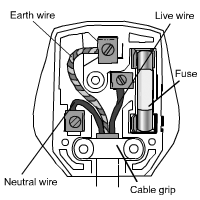Mains Electricity
Voltage and Current
In the NZ, the mains voltage is approximately 230V. It is an alternating current (a.c.) supply.
This means the current is constantly changing direction.
In the NZ, it has a frequency of 50 hertz (Hz) which means it changes direction and back again 50 times per second.
Cells and batteries supply a direct current (d.c.). This means it always flows in the same direction.
Safety
Mains electricity can kill if not used safely.
- Never overload mains sockets.
- Never touch electrical connections with wet hands.
- Replace frayed cables.
- Don't use dirty plugs – they have a high resistance and may overheat.
- Switch off TVs at night.
Electrical appliances are connected to the mains using cable containing two or three copper wires that are covered in flexible plastic.
Copper is a good electrical conductor and plastic is an insulator.

Plugs
This diagram illustrates how a plug should be wired.
To make plugs safe to use they have:
- a plastic or rubber case which does not conduct electricity
- brass pins, because brass is a good conductor
- the correctly sized fuse, which will blow if too much current flows
- an earth pin that is connected to the appliance casing and prevents electric shock
- a cable grip that holds the cable in place and prevents the three wires inside from becoming disconnected
Fuses and Circuit Breakers
A fuse is a piece of wire which gets hot and eventually melts if too much current flows through it, due to a fault in the appliance. This breaks the circuit.
The fuse in a circuit should have a value higher than, but as close as possible to, the current through the appliance when it is working normally.
All metal appliances must be earthed. If a fault in the appliance connects the case to the live wire, and the supply is switched on, a very large current flows to earth and overloads the fuse.
A circuit breaker performs a similar function to a fuse. If too much current flows through the circuit a switch is flicked to break the circuit.
Document Actions

 Like us on Facebook
Like us on Facebook